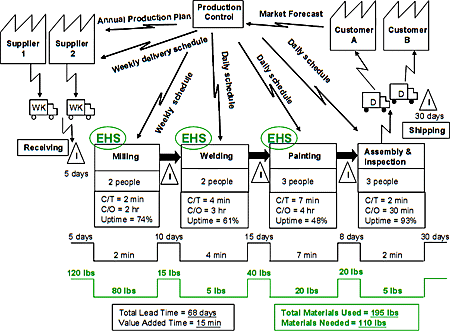What is Lean ?
Lean is commonly recognized as the foremost manufacturing process in terms of quality and productivity. It originated with  Toyota in Japan in the 1950’s (Toyota Production System or TPS) and has been adopted by many manufacturing organizations across the world. It is particularly prevalent in the automotive industry but has also been adopted in other manufacturing industries such as electronics. Lean is increasingly being utilized in service industries such as Finance.
Toyota in Japan in the 1950’s (Toyota Production System or TPS) and has been adopted by many manufacturing organizations across the world. It is particularly prevalent in the automotive industry but has also been adopted in other manufacturing industries such as electronics. Lean is increasingly being utilized in service industries such as Finance.
Lean has a number of key attributes, some of which are described below:-
• The product is DESIGNED for ease of manufacturability. This is to minimize manufacturing defects and reduce the number of manufacturing stages to a minimum.
The key to ‘Design For Manufacture’ is taking into account the manufacturing process at the design stage to ensure that the product will be produced at maximum yield and efficiency. Various tool are employed such as Design Failure Modes Effect Analysis which involves brainstorming the product design features to ascertain which present the greatest risk to yield in the manufacturing process. During prototyping Statistical Process Control (SPC) techniques are used to determine the Capability of the process with regard to the prototype design. The overall aim is to reduce manufacturing defects to an absolute minimum.
• The SUPPLY CHAIN is coordinated using techniques such as KANBAN and JIT (Just In Time) to minimize inventory and increase efficiency.
Just In Time manufacturing eliminates unnecessary process inventory by arranging production to meet customer demand in a ‘pull’ system which relies on signals (kanban) throughout the process to control production. A key benefit is in minimizing work in progress (WIP) throughout the manufacturing process. Unnecessary WIP costs real money in the form of materials and ‘value added’ tied up in the manufacturing process. By applying JIT techniques waste is eliminated and the overall process is accelerated.
• The CUSTOMER is at the heart of the process, customer feedback is sought actively and repeat customers pursued vigorously leading to a large degree of brand loyalty. Techniques such as ‘Quality Function Deployment’ aim to capture the ‘Voice Of the Customer ‘ (VOC) at the product design stage to ensure that the product meets the customer’s expectations.
• PRODUCTION is coordinated from order to delivery, minimizing delivery time and reducing waste.
A key part of adopting a LEAN strategy is the implementation of 5s.5s refers to the following Japanese words and their meaning in relation to LEAN.
Seiri (Sorting)
In order to minimize confusion and increase efficiency anything not in immediate use should be stored out of the way in designated areas.
Seiton (Straightening)
Every tool should be in its place and in line with the workflow.
Seiso (Cleaning)
The workplace should be cleaned regularly and periodically and everything put back in its place.
Seiketsu (Standardization)
Work practices should be consistent and standardized and everyone must know their duties and responsibilities.
Shitsuke (Maintenance)
Enforce the previous 4s whilst reviewing and modifying them as required.
• The combined enterprise is MANAGED and organized with LEAN in mind.
A key technique employed in LEAN organizations is Value Stream Mapping.
Value Stream Mapping
– has a number of key stages:-
1) Identify the Product or Service to be analyzed.
2) Draw the current state Value Stream Map. A number of standard symbols are used to aid common understanding.
3) Identify opportunities to eliminate waste (Muda) which is NVA (None Value Adding)
4) Identify opportunities to increase flow using Kaizen (continuous improvement).
5) Draw a ‘Future State’ Value Stream Map i.e how you want the process to look in the future.
6) Put in place a Project Management plan to implement the required changes.
Adopting a Lean strategy results in enormous increases in efficiency and productivity and subsequent increases in profitability.
Implementing Lean requires the necessary tenacity and expertise gained over many years experience.
Lean is increasingly being adopted across service industries to minimize waste and increase efficiency.
If you want help implementing your Lean process get in touch now.

